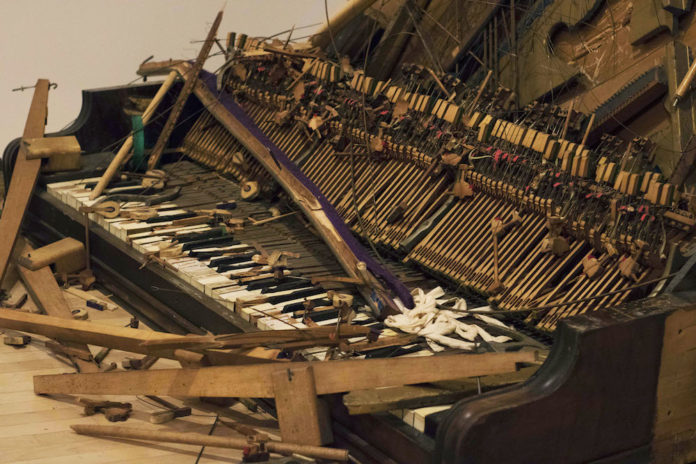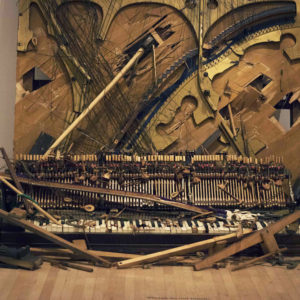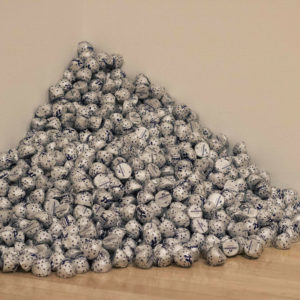
A smashed piano, a corner full of chocolate and two trenches in the desert make up the latest exhibit at the Museum of Contemporary Art (MOCA) in Downtown LA. Entitled “Open House: Gala Porras-Kim,” the exhibit includes works that call attention to the role of art institutions in preserving, creating and presenting works of art. The titular artist Gala Porras-Kim curated the exhibit, which succeeds overall in its vision but makes key compromises and creative decisions that ultimately hold it back.
The exhibit represents the continuation of MOCA’s ongoing “Open House” series, in which LA-based artists curate exhibitions based upon the museum’s permanent collection. The previous installment, “Open House: Elliot Hundley,” featured works selected by the titular artist and explored the topic of collage within MOCA’s collection.
Porras-Kim’s “Open House” centers around MOCA’s role in preserving and exhibiting select works from its collection. For example, Felix Gonzalez-Torres’s “Untitled (Last Light)” leaves the decision of how it is presented to the exhibiting institution’s discretion. The work, consisting of string lights, can be arranged and altered in any manner the institution sees fit. MOCA includes two versions of “Last Light” at the exhibit, with one hanging vertically and the other coiled in circles next to it.
One work by Walead Beshty consists of a cracked glass box and a tattered cardboard box and requires that the former be shipped within the latter as it moves from location to location. The shipping information is then added to the title of the work, making it too long to include here but also reflecting past instances of its exhibition in, and subsequent shipping to, Los Angeles, London and New York City. Both the wear and tear on the boxes and the work’s title reflect the physical role of museums in transporting the work and affecting its condition over time.
Highlights of “Open House” come in the form of the aforementioned piano and candy. Ralph Montañez Ortiz’s “Henny-Penny Piano Destruction Concert” offers a concise encapsulation of the exhibit’s themes. The work includes a video of Ortiz decimating a piano before a captive audience in 1998 — alongside the destroyed piano itself. More than pure violence, however, “Henny-Penny…” presents a “destroyed” object the museum must then preserve. The gutted piano itself acts as a metaphor for MOCA as its internal work to preserve art comes under examination by means of the exhibit.

Another standout work, Felix Gonzalez-Torres’s “Untitled (A Corner of Baci),” gives visitors the opportunity to physically interact with a work. As the name implies, “A Corner of Baci” consists of a corner filled with Italian chocolates which visitors may take and consume. “A Corner of Baci” requires that MOCA continually restock chocolate in order for the work to exist, but also that visitors challenge the notion that they should not engage with art — or eat it, for that matter.
According to Ramara Rubin, an exhibit attendant at MOCA, visitors become excited upon learning they can take the chocolate.
“It’s sort of like a gift,” Rubin said. “People go for it.”
Shannon Overton, another museum attendant, noted that visitors tend to hesitate when confronted by the chocolate, but quickly overcome their inhibition.

Omar De Los Santos, a visitor to the exhibit, felt confused by “A Corner of Baci” at first. He noted that while museum employees had told him he could take a chocolate when he first arrived, he felt compelled to ask a museum attendant for permission. Despite the confusion, he liked the work and how it allows visitors to engage with it.
While “Open House” accomplishes its goal of calling attention to the role of institutions, it falls short in other matters. The exhibit includes only one female artist, Dove Bradshaw, out of the 11 exhibited, creating a jarring disparity in gender representation in the exhibit.
The exhibit also suffers from a confusing creative decision in its inclusion of Michael Heizer’s “Double Negative.” A important work of land art within MOCA’s permanent collection, “Negative” consists of two large trenches carved into the sides of a canyon near Overton, NV that visitors can find via directions on the MOCA website. Per Heizer’s intention, MOCA allows “Negative” to decay with time, “preserving” the work by allowing nature to run its course. Yet to devote a large portion of a wall to a photograph of “Negative” was an ineffective use of space. While it is an important work, “Negative” lacks the immediacy of presence of other works in “Open House.”
Despite some negatives, “Open House” successfully and succinctly envisions its thesis by making clear the relationships between art institutions and works of art. Despite a perhaps limited scope, the included works offer an excellent survey of the exhibit’s themes, even if it leaves something to be desired.
“Open House: Gala Porras-Kim” continues until May 11, 2020.
![]()


































